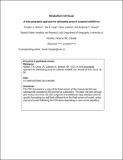Files in this item
A time geographic approach to delineating areas of sustained wildlife use
Item metadata
| dc.contributor.author | Nelson, Trisalyn | |
| dc.contributor.author | Long, Jed | |
| dc.contributor.author | Laberee, Karen | |
| dc.contributor.author | Stewart, Benjamin | |
| dc.date.accessioned | 2016-02-13T00:12:52Z | |
| dc.date.available | 2016-02-13T00:12:52Z | |
| dc.date.issued | 2015 | |
| dc.identifier | 175216487 | |
| dc.identifier | 5d33fb53-8452-4b18-9173-396d4966ebff | |
| dc.identifier | 84926256213 | |
| dc.identifier.citation | Nelson , T , Long , J , Laberee , K & Stewart , B 2015 , ' A time geographic approach to delineating areas of sustained wildlife use ' , Annals of GIS , vol. 21 , no. 1 , pp. 81-90 . https://doi.org/10.1080/19475683.2014.992366 | en |
| dc.identifier.issn | 1947-5683 | |
| dc.identifier.uri | https://hdl.handle.net/10023/8218 | |
| dc.description.abstract | Geographic information systems (GIS) are widely used for mapping wildlife movement patterns, and observed wildlife locations are surrogates for inferring on wildlife movement and habitat selection. We present a new approach to mapping areas where wildlife exhibit sustained use, which we term slow movement areas (SMAs). Nested within the habitat selection concepts of home range and core areas, SMAs are an additional approach to identifying areas important for wildlife. Our method for delineating SMAs is demonstrated on a grizzly bear (Ursus arctos) case study examining road density. Our results showed that subadult females had significantly higher road densities within SMAs than in their potential path area home ranges. The lowest road density was found in the SMAs of adult male grizzly bears. Given increased mortality risks associated with roads, female encampment near roads may have negative conservation implications. The methods presented in this manuscript compliment recent developments to identify movement suspension and intensively exploited areas defined from wildlife telemetry data. SMA delineation is sensitive to missing data and best applied to telemetry data collected with a consistent resolution. | |
| dc.format.extent | 672562 | |
| dc.language.iso | eng | |
| dc.relation.ispartof | Annals of GIS | en |
| dc.rights | © 2015 Taylor & Francis. This work is made available online in accordance with the publisher’s policies. This is the author created, accepted version manuscript following peer review and may differ slightly from the final published version. The final published version of this work is available at https://dx.doi.org/10.1080/19475683.2014.992366 | en |
| dc.subject | Time geography | en |
| dc.subject | Stopover ecology | en |
| dc.subject | GPS telemetry | en |
| dc.subject | Potential path area | en |
| dc.subject | Grizzly bear | en |
| dc.subject | GA Mathematical geography. Cartography | en |
| dc.subject | QH301 Biology | en |
| dc.subject | NDAS | en |
| dc.subject.lcc | GA | en |
| dc.subject.lcc | QH301 | en |
| dc.title | A time geographic approach to delineating areas of sustained wildlife use | en |
| dc.type | Journal article | en |
| dc.contributor.institution | University of St Andrews.Geography & Sustainable Development | en |
| dc.contributor.institution | University of St Andrews.Bell-Edwards Geographic Data Institute | en |
| dc.identifier.doi | 10.1080/19475683.2014.992366 | |
| dc.description.status | Peer reviewed | en |
| dc.date.embargoedUntil | 2016-02-13 |
This item appears in the following Collection(s)
Items in the St Andrews Research Repository are protected by copyright, with all rights reserved, unless otherwise indicated.

